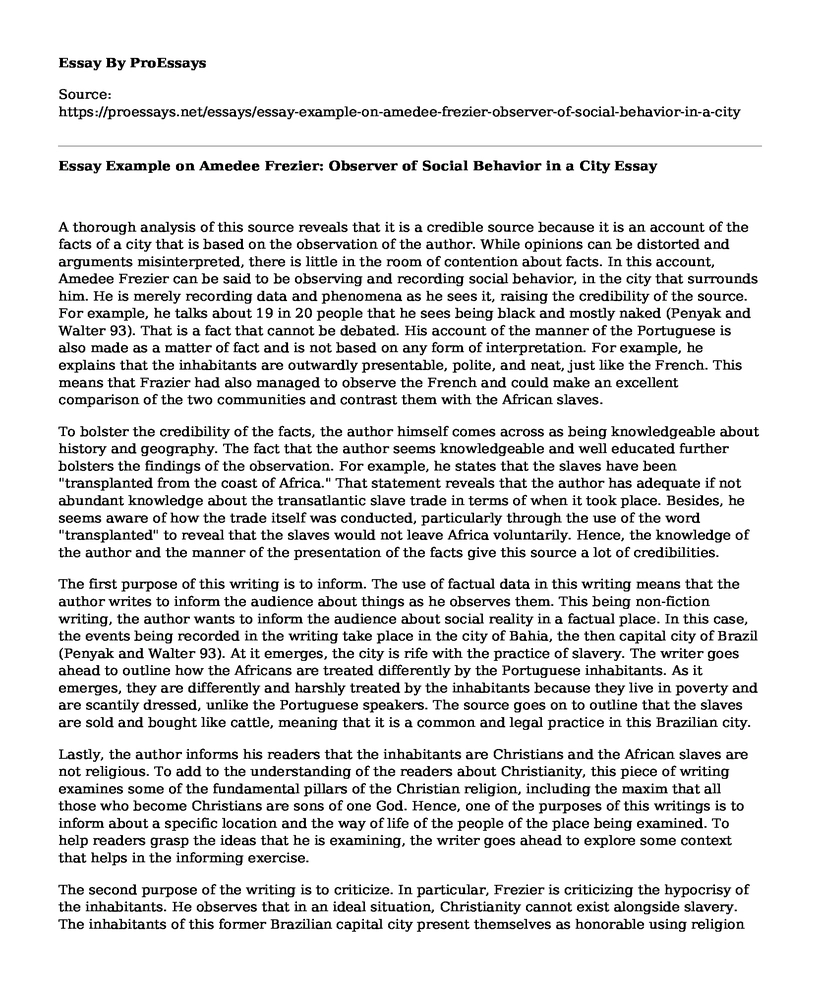A thorough analysis of this source reveals that it is a credible source because it is an account of the facts of a city that is based on the observation of the author. While opinions can be distorted and arguments misinterpreted, there is little in the room of contention about facts. In this account, Amedee Frezier can be said to be observing and recording social behavior, in the city that surrounds him. He is merely recording data and phenomena as he sees it, raising the credibility of the source. For example, he talks about 19 in 20 people that he sees being black and mostly naked (Penyak and Walter 93). That is a fact that cannot be debated. His account of the manner of the Portuguese is also made as a matter of fact and is not based on any form of interpretation. For example, he explains that the inhabitants are outwardly presentable, polite, and neat, just like the French. This means that Frazier had also managed to observe the French and could make an excellent comparison of the two communities and contrast them with the African slaves.
To bolster the credibility of the facts, the author himself comes across as being knowledgeable about history and geography. The fact that the author seems knowledgeable and well educated further bolsters the findings of the observation. For example, he states that the slaves have been "transplanted from the coast of Africa." That statement reveals that the author has adequate if not abundant knowledge about the transatlantic slave trade in terms of when it took place. Besides, he seems aware of how the trade itself was conducted, particularly through the use of the word "transplanted" to reveal that the slaves would not leave Africa voluntarily. Hence, the knowledge of the author and the manner of the presentation of the facts give this source a lot of credibilities.
The first purpose of this writing is to inform. The use of factual data in this writing means that the author writes to inform the audience about things as he observes them. This being non-fiction writing, the author wants to inform the audience about social reality in a factual place. In this case, the events being recorded in the writing take place in the city of Bahia, the then capital city of Brazil (Penyak and Walter 93). At it emerges, the city is rife with the practice of slavery. The writer goes ahead to outline how the Africans are treated differently by the Portuguese inhabitants. As it emerges, they are differently and harshly treated by the inhabitants because they live in poverty and are scantily dressed, unlike the Portuguese speakers. The source goes on to outline that the slaves are sold and bought like cattle, meaning that it is a common and legal practice in this Brazilian city.
Lastly, the author informs his readers that the inhabitants are Christians and the African slaves are not religious. To add to the understanding of the readers about Christianity, this piece of writing examines some of the fundamental pillars of the Christian religion, including the maxim that all those who become Christians are sons of one God. Hence, one of the purposes of this writings is to inform about a specific location and the way of life of the people of the place being examined. To help readers grasp the ideas that he is examining, the writer goes ahead to explore some context that helps in the informing exercise.
The second purpose of the writing is to criticize. In particular, Frezier is criticizing the hypocrisy of the inhabitants. He observes that in an ideal situation, Christianity cannot exist alongside slavery. The inhabitants of this former Brazilian capital city present themselves as honorable using religion as part of their nobility. However, rather than adhere to the maxims of Christianity, including the equality of all believers, the inhabitants practice slavery, a practice whose maxim is quite the opposite of Christianity. For example, the practice of slavery, as outline by Frezier is barbaric. Slaves are bought and sold start naked and the owners have the right to punish the slaves, if necessary, by death. In order to serve the white community best, the slaves are so many that for every one white person, there are about twenty slaves (Penyak and Walter 93).
Conclusion
After being bought like cattle, the slaves spent most of their time performing hard labor and with little clothes on their backs. In contrast, the Christian religion is based on high ideals as the author explains. For example, as Frezier explains, Christians become members of the same body irrespective of the skin color. On baptism, the slaves should become sons of God, just like the white inhabitants. Therefore, as Christians, the white inhabitants should treat the black race with dignity. However, the whites appear comfortable, claiming to be religious while still practicing slavery. By contrasting the maxims of Christianity and the inner workings of the institution of slavery, Frezier is able to criticize the white inhabitants and show their religious hypocrisy.
Work Cited
Penyak, Lee M, and Walter J. Petry. Religion in Latin America: A Documentary History. Maryknoll, N.Y, Orbis Books, 2006.
Cite this page
Essay Example on Amedee Frezier: Observer of Social Behavior in a City. (2023, Jul 02). Retrieved from https://proessays.net/essays/essay-example-on-amedee-frezier-observer-of-social-behavior-in-a-city
If you are the original author of this essay and no longer wish to have it published on the ProEssays website, please click below to request its removal:
- UK's Ethnic Minorities Struggle with FGM: A Background and Rationale
- Essay Sample on Comparing Christianity and Islam: A Historical Overview
- Essay Example on 83-Year-Old Woman's Journey Through Late Adulthood: An Interview
- Mother-Son Bond in We Need to Talk About Kevin - Essay Sample
- EMC vs Face-to-Face Communication: A Comparison - Essay Sample
- Experiencing Autism: The Challenges, Isolation, and Need for Change in Utah - Free Essay
- Free Essay Sample on Interpreting Bible Scriptures







